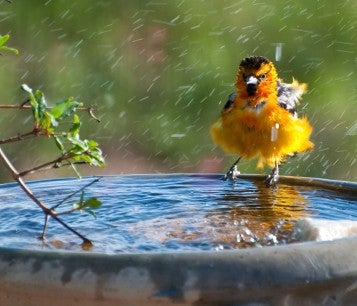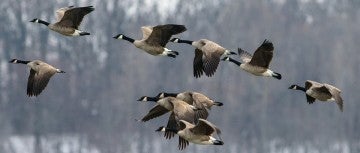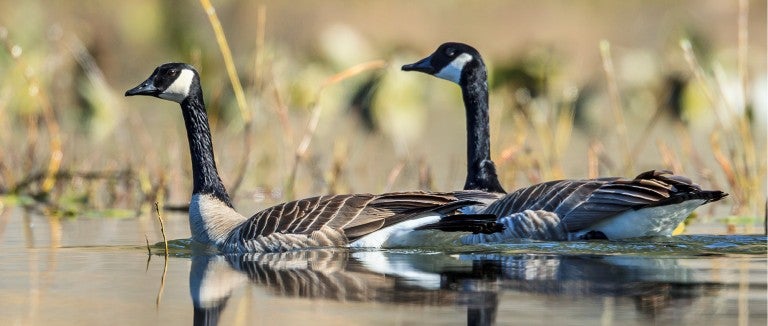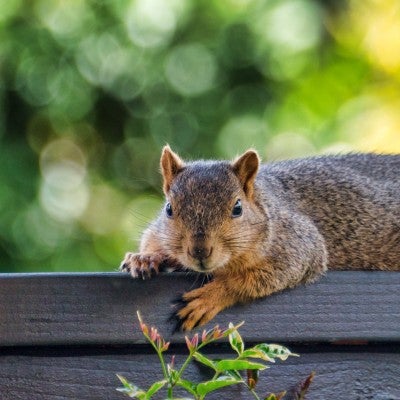Rounding up and killing entire flocks of geese has become an all-too-common (and temporary) fix in many communities. Besides being inhumane, this also leaves room for a new flock to just move right in. Geese shouldn’t be killed for doing what comes naturally, especially when long-term, effective and humane solutions for conflicts exist.
Humane programs have been successfully resolving conflicts with resident Canada geese in many communities for years. The best geese control programs combine three methods: limiting flock growth, frightening geese (humanely) so they decide to leave on their own and changing the habitat so it isn’t attractive to geese. Learn how to apply and combine these methods together.
Contents
- Why do some people consider geese a problem?
- What’s the difference between resident and migratory Canada geese?
- Why don’t resident Canada geese migrate?
- Are goose droppings harmful to people?
- Are geese dangerous?
- Why shouldn't I feed geese?
- How can I keep geese away from areas where they’re not welcome?
- What are Canada goose roundups and why are they inhumane?
- Why doesn’t killing geese work?
- Aren’t geese protected by law?
- My community is planning to kill geese. What can I do?
- Do I need a permit to implement a humane goose management plan?
- Additional resources
Why do some people consider geese a problem?
Canada geese tend to hang around places where people like to recreate, such as parks, ball fields, golf courses, lakes and picnic spots, and some people object to the droppings they leave on grass and walkways. Others may be alarmed by the defensive actions geese will perform to warn off people who get too close to their nests or goslings.
Geese can be a cause for concern if they live around airports. For the safety of both air travelers and wildlife, airports need long-term programs to permanently reduce the conditions that attract geese to airports, move geese immediately away when they are in protected airspace and work to instill learned avoidance in flocks that reside near airports or other places where they cause conflicts.
What’s the difference between resident and migratory Canada geese?
“Resident” Canada geese are defined as those geese that stay within the lower 48 states year-round and do not migrate north to Canada during nesting season (like “migratory” Canada geese do in the fall). Resident and migratory Canada geese differ in behavior only; they are both the same species of geese and are both protected by the Migratory Bird Act.
Why don’t resident Canada geese migrate?
There was a time when Canada geese, decimated by hunting and habitat loss, were rarely seen in the lower 48 states. Then in the 1960s, the federal government and state wildlife agencies started breeding the birds and relocating them throughout the U.S. Geese learn to migrate from their parents and flock (they’re not hatched with the knowledge), so the descendants of these captive-bred animals never learned to migrate to their traditional nesting grounds in Canada. These “resident Canada geese” now live year-round in cities and suburbs where expansive lawns, parks, golf courses and artificial ponds make perfect goose habitats.
What are Canada goose roundups and why are they inhumane?
In some communities, Canada geese are rounded up and killed because people find them to be a nuisance, particularly when goose droppings accumulate. Most round-ups occur during the birds’ annual molt when they are growing new flight feathers and can’t fly—from mid-June through July. Canada geese congregate where they find food and safety from predators to molt.
Once they gather together and can’t fly away, they are readily caught. Young birds will not have developed the ability to fly yet and are easily gathered in round-ups as well. The geese are typically herded into pens and then packed into crates before being killed by carbon dioxide gas (a painful and distressing death), often in small chambers on the back of trucks at the roundup site.
Sometimes, the geese are trucked to slaughterhouses. Because their meat can’t be sold, it may be offered to food banks to create the false impression that the killing serves a charitable purpose. In reality, goose meat is often contaminated with lead, pesticides and other toxicants, and food banks often reject these donations.
Why doesn’t killing geese work?
Rounding up and killing geese is a temporary fix at best, as it just leaves room for a new flock to move right in. The best and most effective way to solve conflicts with Canada geese is with a multipronged plan that humanely reduces the goose population and changes the habitat so it’s less attractive to geese.
Aren’t geese protected by law?
The Migratory Bird Treaty Act ostensibly protects Canada geese, making it illegal to harm them, their eggs or their nests. However, that only means people can’t harm birds without a permit from the U.S. Fish and Wildlife Service, which frequently gives property owners permission to kill Canada geese in urban and suburban areas.
No matter how big or small your outdoor space, you can create a haven for local wildlife. By providing basic needs like water, food and shelter, you can make a difference in your own backyard.

Are goose droppings harmful to people?
Research has not found any significant health threats from goose feces. Of course, you want to avoid contact with any animal feces. Ordinary good hygiene, such as washing hands and leaving shoes at the door, are adequate prevention if you accidentally contact goose droppings.
Why shouldn't I feed geese?
Canada geese do not need food from humans. Even in severe weather, these birds find nutritionally appropriate food for themselves, moving considerable distances to better forage when necessary. If fed an inappropriate diet, such as human foods and commercial poultry feeds, young waterfowl are prone to develop a wing deformity called angel wing, slipped wing or dropped wing. This permanent deformity prevents or limits flight—a very severe handicap for a wild bird. Inappropriate food can cause other less obvious problems by replacing nutritious food with “empty calories,” much like chips and candy for people.
The feeding of geese by people also causes them to congregate in public areas, increasing conflicts and the accumulation of droppings. In some cases, geese that are fed by people can even become aggressive in their quest for more handouts.
Are geese dangerous?
Canada geese pose little threat to people, but they will defend their nests and goslings. Unsuspecting people can get too close and inadvertently provoke defensive responses by the parents, such as hissing, wing-flapping or charging. If this happens, simply back away. You can help the geese and any passersby by marking off the nest with highly visible warnings, such as cones with caution tape.
My community is planning to kill geese. What can I do?
Commercial pest control firms and the U.S. Department of Agriculture’s Wildlife Services carry out many of the roundups and killing of geese. The costs are borne by taxpayers when the geese are on public property and by homeowner associations when the geese reside on HOA property. Taxpayers and HOA members have a right to demand their money be spent ethically and effectively, not squandered on killing geese. Tell your elected officials or your HOA-elected board that lethal roundups are ineffective and unacceptable and that there are better ways to control the goose population.
Our "Coexisting with Canada Geese" advocate toolkit offers steps you can take to encourage the adoption of a humane geese management plan, including fact sheets you can distribute to your community and sample language for social media posts, letters to officials, testimony before a municipal council and more.

How can I keep geese away from areas where they’re not welcome?
Conflicts between people and Canada geese will be resolved by individuals and communities that care about the birds, the environment and the well-being of their communities—individuals like you and communities like yours.
There is no single quick fix that will resolve human-goose conflicts at every site. But well-designed programs can make a major difference. The best geese control programs follow a seasonal plan based on goose biology and behavior (refer to page 5 of our "Solving Problems with Canada Geese" management plan) and combine at least two of the following three key elements:
1. Limit flock size
Since Canada geese often return to the nest where they hatched to raise their own young, curtailing reproduction can lead to fewer geese nesting at a given site in the future.
The humane way to limit flock growth and stabilize goose populations is to keep eggs from hatching. In a process known as “addling,” eggs are treated with corn oil or removed from the nest, which is humane if done at the earliest stages of development.
Addling limits the number of geese in places people don’t want more. And it frees adult geese from tending flightless goslings, so they can be encouraged to move elsewhere before summer conflicts are greatest.
Before instituting an egg addling program, it is necessary to learn the proper methods for addling Canada goose eggs (see our egg addling protocol) and to register with the USFWS.
2. Scare geese away
Harassing or scaring geese away so they learn a site isn’t a safe place is an effective technique for solving conflicts with geese when used in conjunction with an egg addling program.
The most effective way to scare geese away is with specially trained goose-herding dogs working with a handler. These dogs convince the geese the site isn’t safe for them (but must never catch or harm geese).
Many devices designed and sold to scare away geese (such as coyote decoys, fake owls and snakes, floating alligator heads, and dead goose decoys) simply do not work to deter geese (or at least not for long). Lasers and other light-emitting devices specifically designed to scare birds are useful at dusk as geese settle down for the night—scaring birds away from night roosts means they will start their day elsewhere.
Another option is to use chemical repellents, which can be dispersed as a fog or sprayed on grass to keep geese away from high-priority areas. Loud noises (such as pyrotechnics and propane cannons) can also be useful in places like airports for scaring geese away.
Site aversion efforts are most effective before nesting season in the spring and after geese regain their flight feathers in the summer. Don’t attempt to scare away geese who are nesting, molting or raising young goslings who don’t yet have their flight feathers.
3. Modify the habitat
The best way to avoid Canada goose problems (and often the most cost-effective in the long run) is to change the habitat so it doesn’t appeal to them. Geese feel safe from predators where there are open sight lines, so they can see predators coming, and where they can easily escape onto open water.
To make an area less attractive to geese, use dense, tall plantings or stands of trees along shorelines to make a barrier between food and water, and locate ball fields and other grassy expanses as far from open water as possible. Reduce the total amount of lawn and reduce the young grass shoots geese like the most. Let grass grow taller, at least six inches, and leave taller grass over winter. Stop or limit watering and fertilizing in the spring. Replace Kentucky bluegrass, i.e. “goose candy,” with other grasses, such as tall fescue.
Since geese will gather where they’re fed, it’s also important to let people know that human food isn’t healthy for geese and that feeding the birds can thwart humane management efforts.
Habitat changes work better if geese can go to a “tolerance zone” that meets their needs. Leave tolerance zones—and the geese in them—alone, and the geese will more readily vacate the areas where they’re not welcome.
Do I need a permit to implement a humane goose management plan?
Geese may be harassed or scared away without a permit as long as the geese, goslings, eggs and nests aren’t harmed. The USFWS allows communities to treat resident Canada goose eggs to prevent hatching (a process called addling) after registering online. Some states require you to get their permission as well.

